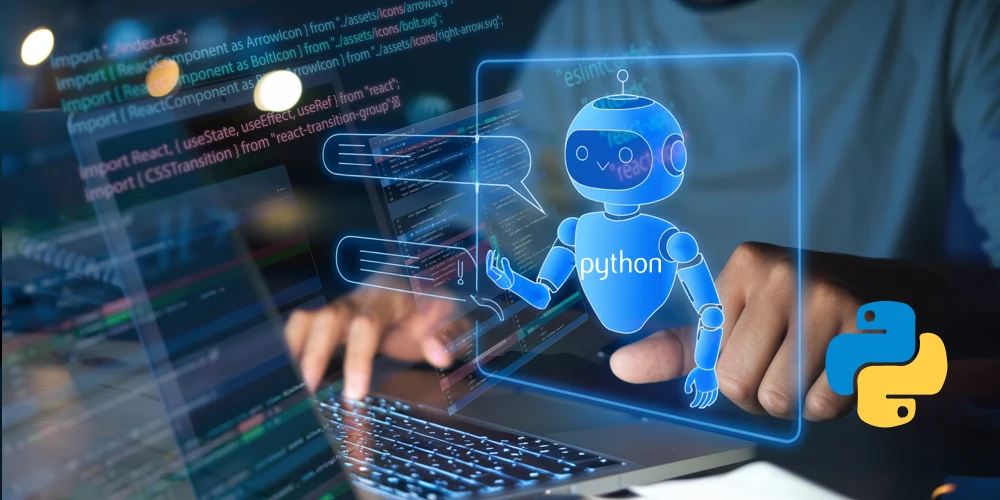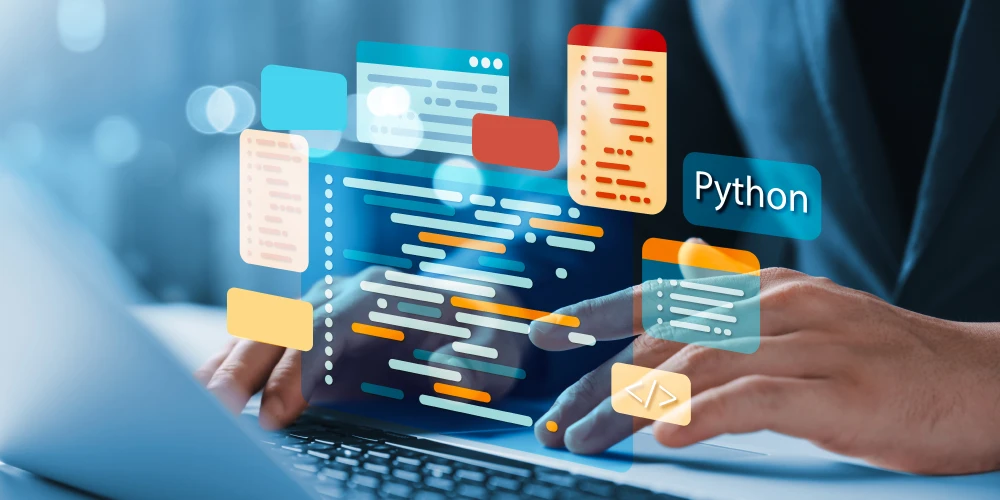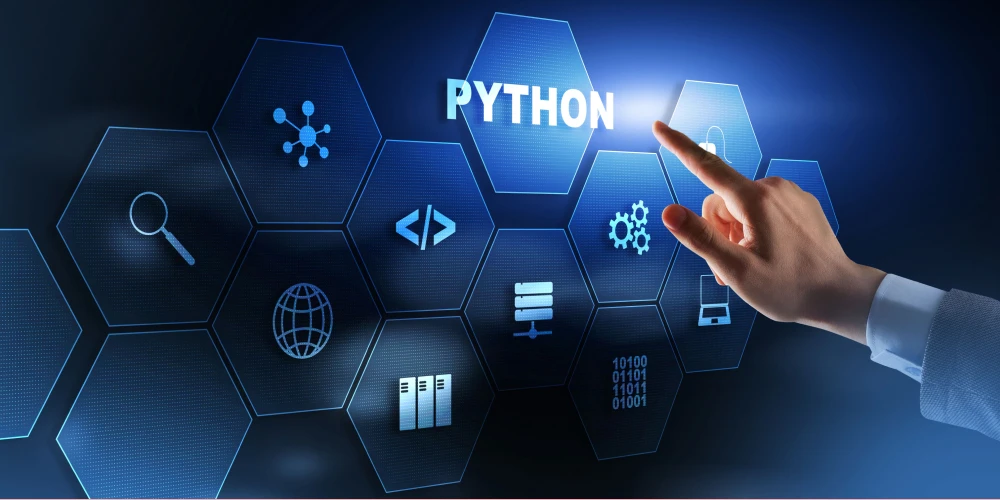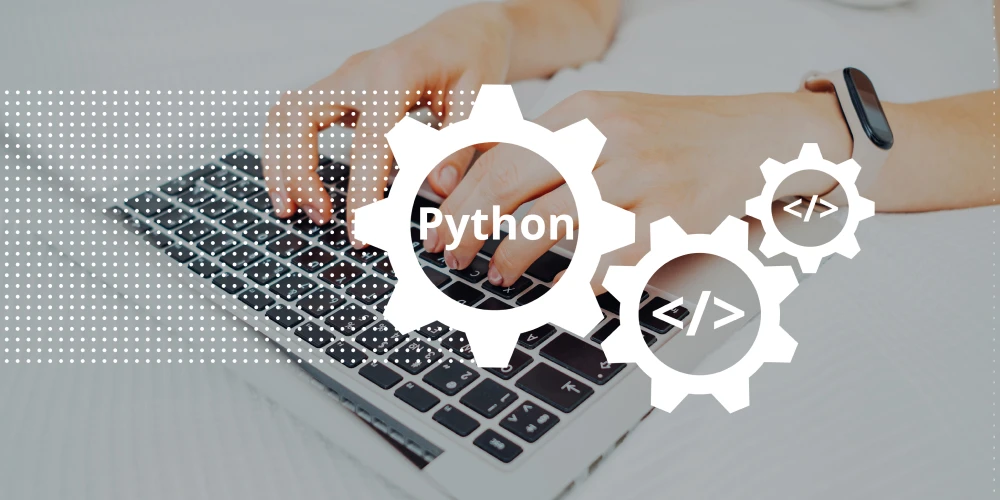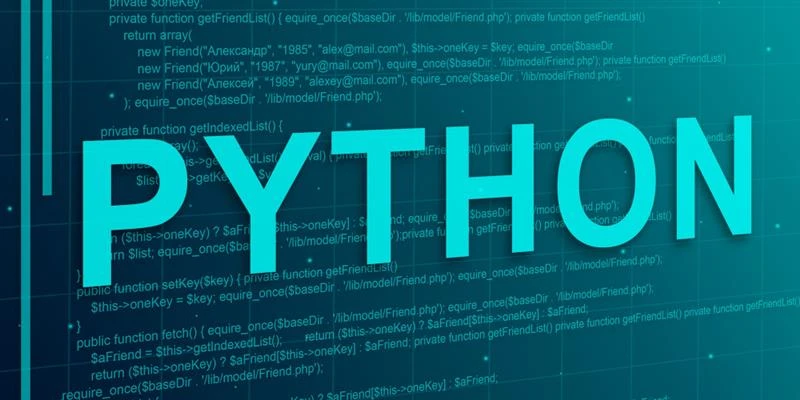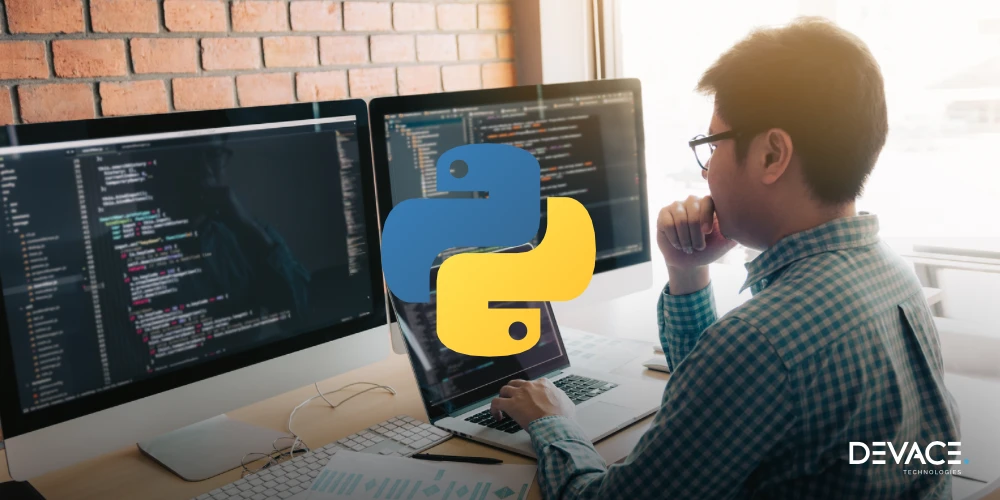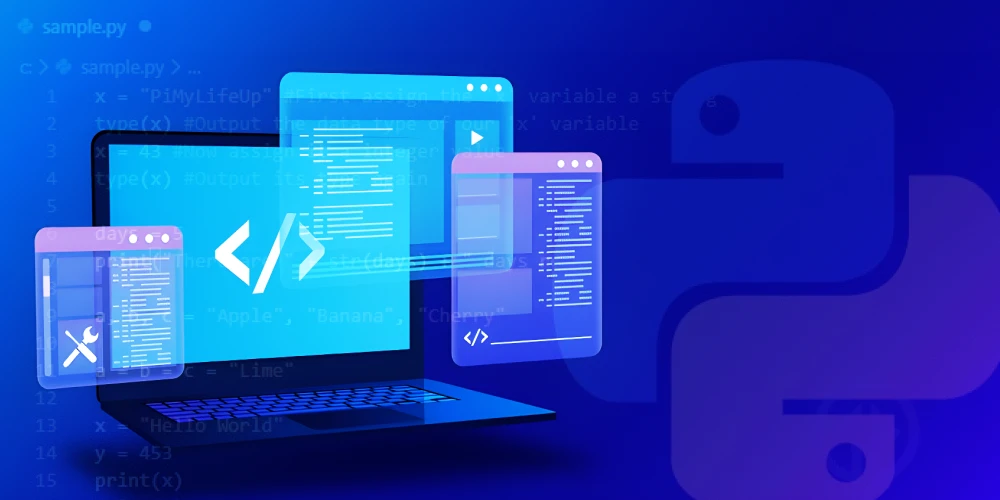With the advancements of AI, they have not only become our assistants but also search engines. Previously, chatbots were used to answer general queries for users who visit a certain website, but the game has changed with ChatGPT, Gemini, and other chatbots. For building a chatbot, several technologies are used.
Chatbots have become an integral part of daily routines, whether it is for developers use, business use, or other uses. They have intrigued companies worldwide to make intelligent chatbots using different technologies. Python stands at the top.
In this blog, we will explore how to make a chatbot in Python by following all the required steps. Let’s get started.
What is a Chatbot?
A chatbot is a human program that simulates human conversation digitally. It provides information, answers queries related to subject matter, and helps people understand technically complex questions or situations. Chatbot uses predefined rules and natural language processing (NLP) to understand the user input and generate responses/answers accordingly.
Types of Chatbots
There are two types of chatbots that are used to generate answers i.e., rule-based chatbots or AI-powered chatbots. Both of them are in usage, however Artificial Intelligence powered chatbots are more in use.
Rule-based Chatbots
If we talk about rule-based chatbots, then these follow a set of scripted flows. As the name suggests, these chatbots only respond to a specific type of queries and commands.
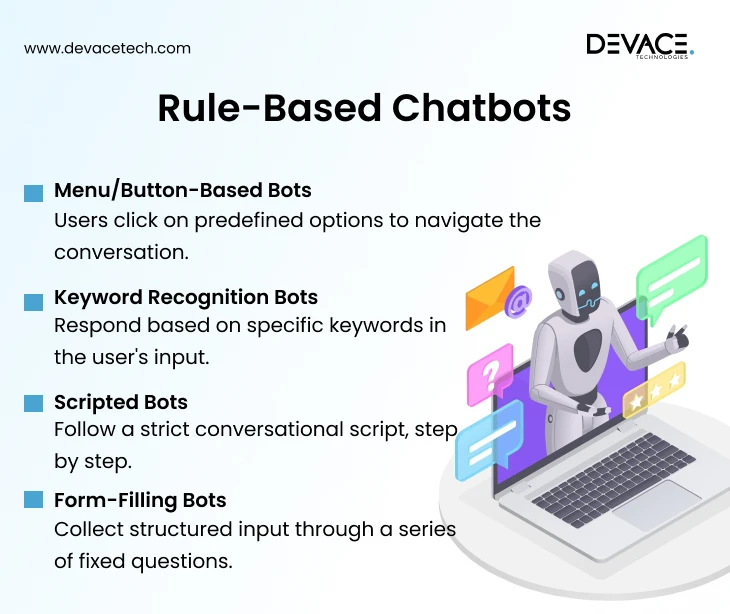
AI-powered chatbots
On the other hand, we have AI-powered chatbots that use machine learning and NLP to first understand context, learn from interactions, and provide more natural or flexible response that does sound human and backed by research.
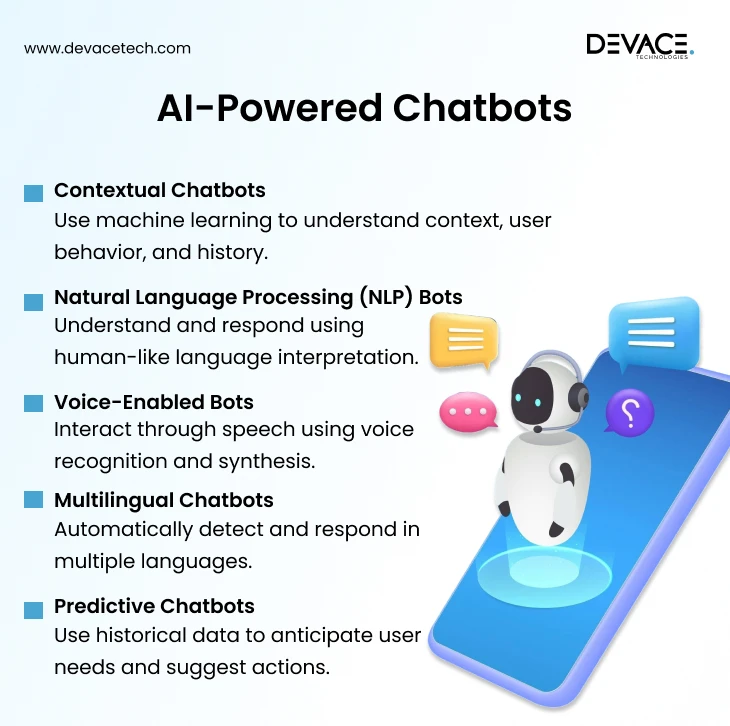
Chatbots are widely used in almost every industry starting from customer service, eCommerce, banking, healthcare, and more to automate interactions, reduce support costs, and provide 24/7 assistance.
What is ChatterBot?
It is a Python-based library that is designed to simplify the process of creating conversational chatbots, and it is the topmost for building a chatbot in Python. What it does is that it enables developers to build chatbots that can learn from existing conversations and respond intelligently by using the latest technologies, such as machine learning algorithms under the hood. In the US, ChatterBot is one of the most used Python libraries for beginners to create chatbots and learn how the algorithm works. So, if you are making a website with Python, then creating a chatbot with the same technology would be the best.
Unlike platforms that require extensive knowledge of natural language processing (NLP), ChatterBot provides a high-level API that makes it accessible even to those relatively new to AI or chatbot development.
If we talk about the core idea behind ChatterBot is to allow the bot to learn and improve over time through training. It supports multiple training methods, including pre-packaged corpora and custom data inputs. One of its standout features is the ability to store conversation history in a database, such as SQLite or MongoDB, which enables the chatbot to remember and refine its responses over time.
What does it have?
ChatterBot has a built-in training module called ChatterBotCorpusTrainer that includes various datasets across different topics like greetings, conversations, computers, science, and more. You can also use ListTrainer for feeding in domain-specific conversations, such as company FAQs or customer support dialogues.
Because it’s built on top of Python, ChatterBot can be easily integrated with web frameworks like Flask and Django, making it highly extensible for real-world applications. Whether you’re building a customer service assistant, an FAQ bot, or a personal productivity tool, ChatterBot provides a straightforward way to get started with building a chatbot.
However, it must be noted that ChatterBot is best suited for smaller projects or proof-of-concept applications. For more complex bots that require advanced NLP features like intent classification, entity recognition, or voice input/output, you might want to explore more robust platforms such as Rasa, Dialogflow, or Microsoft Bot Framework.
Overall, ChatterBot offers an excellent starting point for developers and businesses looking to experiment with chatbot functionality without investing in complex AI infrastructure upfront. Being a software development company, we leverage ChatterBot to create Python-powered chatbots, and they perform extremely well.
Now you know about ChatterBot, the next question is how it works. The heading below explains that in a precise yet detailed manner.
How Does ChatterBot Work?
ChatterBot (a Python library) uses machine learning algorithms to create answers or generate output based on the input it receives, along with the data that has been used to train it. Also, the working principle of ChatterBot is that it employs a logic adapter architecture. This means when a user inputs a message, the chatbot processes it through a series of adapters that determine the most appropriate response.
Now let’s talk about the training phase.
In this phase, the bot is exposed to a dataset. Now, if you think about which dataset? It comes either from a pre-built corpus or a custom list of conversations. This dataset is stored in a database, allowing ChatterBot to build a mapping of questions to answers. Over time, as more data is added or as the bot continues to interact with users, its ability to generate contextually accurate responses improves.
ChatterBot uses a storage_adapter to manage how conversation data is stored and retrieved. By default, it supports SQLite, which is suitable for small-scale projects, but you can configure it to use more scalable databases like MongoDB for larger applications. This flexibility makes it easy to transition from development to production environments, which is why developers in the US prefer to use this Python library.
Different functionalities are used in it. The real-time functionality is powered by the get_response() method. When a user sends a message, the method searches the database for the closest match based on semantic similarity and previous response patterns. Then, it returns what it considers to be the most appropriate reply. If no suitable match is found, you can configure fallback responses or have the bot indicate it doesn’t understand the query.
ChatterBot also supports multiple logic adapters, such as:
- BestMatch (default): Selects the best known response based on input similarity.
- MathematicalEvaluation: Solves math problems in queries.
- SpecificResponseAdapter: Returns predefined responses for specific inputs.
If the Python developers use these functionalities and logic adapters, they can fine-tune the bot’s behavior and build more intelligent systems tailored to their domain.
If we talk about the pros and cons of ChatterBot, it lacks advanced NLP features found in larger frameworks. But its modular, extensible design makes it a great tool for building simple, functional bots that can learn and adapt over time with minimal setup.
Create a fully trained chatbot
Making a Python Chatbot Using a ChatterBot
To build a Python chatbot, developers use a top Python library, i.e., ChatterBot. It is the best library if you are just starting with Python, as it abstracts away much of the machine learning complexity and enables you to build a functional chatbot with minimal setup.
Here is how you can build one from scratch using the steps mentioned below:
Step 1: Install Required Libraries
It is important to set up the environment before you start writing the code to make a chatbot in Python. ChatterBot is not part of the standard Python library and which is why you will also need the chatterbot_corpus to get pre-built conversational data.
Here are the Python comments you can use:
pip install chatterbot==1.0.5 pip install chatterbot_corpus
Pro Tip: ChatterBot works best with Python 3.6–3.8. Newer versions of Python may require patching certain dependencies like spacy or sqlalchemy.
Also, you have to make sure that you have activated your virtual environment before you install it. It will help in avoiding conflict with other projects.
Step 2: Import Necessary Modules
Once you have installed it, you will need to bring in the core classes to start working with the chatbot. These include the ChatBot class itself and the training module.
Below is the code you will need to import the necessary modules:
from chatterbot import ChatBot from chatterbot.trainers import ChatterBotCorpusTrainer
- ChatBot: Creates an instance of your chatbot.
- ChatterBotCorpusTrainer: Trains your bot using the included conversation sets.
As above, we have mentioned the necessary modules that can help you get started with it. That being said, the modular architecture, while building a chatbot in Python, allows for switching trainers (e.g., for custom datasets later).
Step 3: Create a Chatbot Instance
In this step, as mentioned, you will start by initiating an AI chatbot in Python. For this, you will have to give it a name and complete the configuration system.
chatbot = ChatBot( 'DevBot', storage_adapter='chatterbot.storage.SQLStorageAdapter', database_uri='sqlite:///database.sqlite3' ) This setup:
- Uses SQLite for local storage (ideal for development).
- Creates a file database.sqlite3 to save trained data and conversations.
- Allows your bot to “remember” responses across sessions.
You can later migrate to PostgreSQL or MongoDB for production environments.
Step 4: Train the Chatbot
When AI chatbots are trained, a corpus is used (which is a collection of data or to be precise you can say written texts, especially the entire works of a particular author or a body of writing on a particular subject).
As we are making a chatbot using Chatterbot in Python, so it includes a built-in corpus of standard conversational topics such as greetings, small talk, weather, and general knowledge.
trainer = ChatterBotCorpusTrainer(chatbot)
trainer.train('chatterbot.corpus.english')
By using this command, you will be able to download and train your bot on various modules like:
- greetings
- conversations
- computers
- Science
- And other answers that are related to your service/product
This makes your bot functionally useful even before adding custom logic, enough to get started when it comes to training.
Step 5: Create a Chat Loop for Interaction
Now, you have to create a loop for interaction. It is an important part of the step as you will be able to simulate the conversations between computers and humans.
print("Talk to DevBot! Type 'exit' to quit.")
while True:
query = input("You: ")
if query.lower() == 'exit':
break
response = chatbot.get_response(query)
print("DevBot:", response)
This loop:
- Waits for your input
- Sends it to the chatbot
- Prints the generated reply
While it’s a CLI version, this same logic can later be used inside a web app or REST API.
However, you must know the Python best practices to follow when it comes to developing chatbots.
Step 6: Add Custom Training Data
The next step is where you have to add custom training data because you have to make your chatbot trained to the custom questions related to your service or your product. In case of real-world use cases (e.g., support bots, product recommendation bots), you’ll need to train your bot with specific business information.
Below is the code you can leverage to add custom training data in the space of placeholders.
from chatterbot.trainers import ListTrainer custom_trainer = ListTrainer(chatbot) custom_trainer.train([ "What is Devace?", "Devace is a full-service software development company.", "What services do you offer?", "We specialize in web development, AI, and eCommerce platforms." ])
Here is a pro tip for you that adding FAQ-style training enhances relevance and makes the bot feel more intelligent within your niche.
Conclusion
It is best to hire remote developers when it comes to leveraging the algorithms of ML and NLP to create a chatbot. The developers enable you to create a fully robust system. ChatterBot is the best Python library without any doubt, and therefore, in the United States, it is the most recommended for developers.
Hire Python Developers With Devace Technologies
Want to make a chatbot for your website? Let Devace Technologies help you in making the perfect Chatbot using Python, as our developers have helped over 100+ websites to have robust chatbots, delivering a top-tier customer experience.
Hire a developer today to get started with making a perfectly trained chatbot!
Frequently Asked Questions
Is Python a suitable language for building chatbots?
Yes, it is one of the most suitable languages for building chatbots as it has a simple and easy-to-understand syntax, a large number of libraries (like ChatterBot, NLTK, and spaCy). Not only that, but the support for machine learning and natural language processing makes it a strong choice for chatbot development, whether you’re building rule-based bots or AI-driven ones
What makes ChatterBot a better choice than other Python libraries for chatbot development?
If you are a beginner developer, ChatterBot has more features and a robust architecture that will help you to start. It offers built-in machine learning algorithms that allow bots to improve their responses over time.
ChatterBot requires minimal setup, offers clear documentation, and suits educational or small to medium-scale projects, unlike more complex frameworks.
What’s the process for creating a Discord bot using Python?
If you want to create a Discord bot by using Python and its libraries, then you use the discord.py library. The steps involve setting up a Discord developer account, creating a bot token, writing a script using the library to handle events like messages or commands, and then running the bot from your local environment or hosting it on a server. You can extend the bot’s functionality with APIs, commands, or AI responses.
How can I train a chatbot with the ChatterBot library?
You must train the chatbot by exposing it to a corpus—a dataset collected based on how and what you want the chatbot to learn. Not only that, but it also involves feeding it structured conversation data using the ListTrainer or ChatterBotCorpusTrainer classes.
Over time, ChatterBot uses these inputs to build a knowledge base, enabling it to respond to queries more accurately.
What are the steps to build an AI-powered chatbot in Python?
For building an AI-powered chatbot in Python, you’ll start by choosing a library like ChatterBot or integrating NLP frameworks like spaCy or Transformers. Then, you’ll define training data, implement logic for understanding and generating responses, and add functionality like context handling. Optionally, you can integrate machine learning models or APIs like OpenAI’s GPT to make the bot more intelligent.
How can you connect a Python chatbot to a website?
You can integrate or connect a Python AI chatbot with a website by exposing it through a backend service (using Flask or Django) and connecting it to the frontend via JavaScript or WebSocket. The chatbot script runs server-side, processing user inputs and returning responses to the client-side chat interface embedded in the website.
